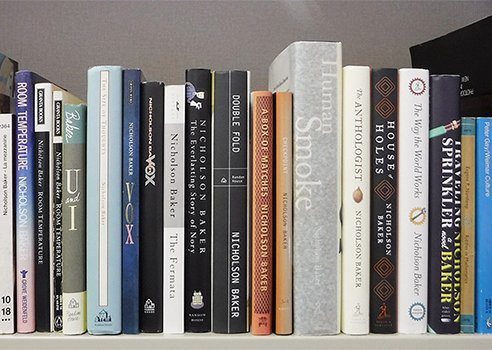Reading time: Less than 3 minutes
I like to share interesting pieces of figurative language I encounter in my reading. I write today about some metaphors from Nicholson Baker…
The book The Mezzanine by Nicholson Baker will not be to everyone’s taste. It’s very short (142 pages) but a slow read, laden as it is with artful writing and numerous footnotes. I found it hilarious and engaging, even though it took me a full 10 days to read it.
The story is about nothing more than a man buying a pair of new shoelaces. But the writer’s enthralment with a large number of technical matters (such as how staplers operate) and his fanatically keen observational skills, make the book ever so much more.
Here are some examples of the figurative language I particularly enjoyed:
- At a few minutes before twelve, I stopped working, threw out my earplugs and, more carefully, the remainder of my morning coffee — placing it upright within the converging spinnakers of the trash can liner on the base of the receptacle itself.
- First, before the stapler arm makes contact with the paper, the resistance of the spring that keeps the arm held up; then, second, the moment when the small independent unit in the stapler arm noses in to the paper and begins to force the two points of the staple into and through it; and, third, the felt crunch, like the chewing of an ice cube, as the twin tines of the staple emerge from the underside of the paper and are bent by the two troughs of the template in the stapler’s base, curving inward in a crab’s embrace of your memo and finally disengaging from the machine completely.
- It [a tie] was made of a silk that verged on crepe, and its pattern was composed of very small oval shapes, each containing a fascinating blog motif that seemed inspired by the hungry, pulsating amoebas that absorbed excess stomach acid in Rolaids’ great dripping-faucet commercial, and when you looked closely you noticed that the perimeter of each oval was made of surprisingly garishly colored rectangles, like suburban tract houses; a border so small in scale, however, that those instances of brightness only contributed a secret depth and luminosity to the overall somber, old-masters coloration of the design.
- As we drew close to the next floor, I could see a green glow coming from under the crenellated slit where the escalator steps disappeared; and as soon as I stepped off, onto oddly immobile linoleum and then a tundra of carpeting, the soft sounds reached me from some department I knew nothing about, like the “Miss” department: clicking of hangers with metal hooks and plastic armatures, hangers that were not heavily loaded with men’s anechoic wool suits but rather were shouldering light, knitted burdens in tight school-girl circles around a cardboard clearance sign.
- The idea of a cross-section of olive-encircles pimiento set like a cockatoo’s eye in the white stretch of cream cheese hit me very hard as an illustration of the same principle I had rediscovered that morning: on their own, olives are old, pickled, briny, rusty — but set them off against a background of cream cheese and you have jewelry.
- And [after dinner at a restaurant] just as our signature is freed into illegibility by the wine, so you imagine that the very ink in the pen adheres more readily to the tiny pores on the surface of the ball because it has been warmed by your body and by the flow of all this conversation. Rarely do pens go dry in restaurants.
- You heard the moans of vertical tradewinds in the elevator shafts, and the clinking of what seemed to be very heavy sets of chains, anchor gauge, possibly safety chains sinking in heaps onto a basement concrete pad as the cars answered their call buttons.
- I regarded the big motionless backs of shoppers ahead of me on the crowded slope with new interest, and I relaxed with them; it was natural, it was understandable, it was defensible to want to stand like an Easter Island monument in this trance of motorized ascension through architectures of retailing.
- A third [woman] is deciding whether she wants a Revlon eyelash curler, which looks like a cross between a tea strainer and a medieval catapult.
Aren’t his observations utterly remarkable?


